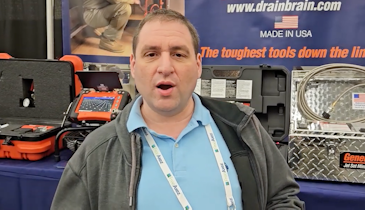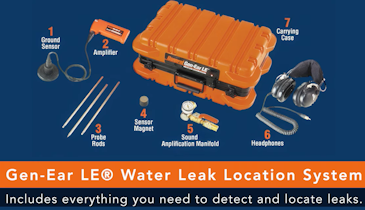
Using artificial intelligence is getting easier with smartphones, tablets and computers and the ways to use it is also quickly expanding. Plumbers can use it in many ways including marketing, billing, and answering phone calls and text messages.
Interested in Business?
Get Business articles, news and videos right in your inbox! Sign up now.
Business + Get AlertsDo you remember the days when plumbing companies had three or four office workers typing quotes, managing inventory and keeping the books by hand? With the advent of technology, those three jobs were rolled into one. It’s amazing what computers have done for business operations.
Anmol Bhasin, ServiceTitan’s chief technology officer, is seeing another seismic shift happening in the business sector — the arrival of artificial intelligence. Artificial intelligence is the ability of a digital computer or computer-controlled robot to mimic human intelligence to reason, learn, self-correct and perform complex tasks. Bhasin says that AI has the potential to revolutionize the trades industry to an even greater extent than computers did in the 1980s.
“I’ve been around AI and machine learning for a majority of my career, and I’ve seen many different variations,” he says, “but I have never seen what has happened in the last 12 months. Never.”
BECOMING MORE AVAILABLE
The major change Bhasin noticed is the widespread availability of AI tools. “Smaller companies now have the access to what large companies had,” he says.
Historically, AI was difficult to harness because its systems were based on sophisticated algorithms and complicated mathematics. The complexity of machine learning prevented AI from being available at large. That’s no longer the case.
“That’s the biggest change that has happened,” Bhasin says. “The learning curve has changed so dramatically that it’s become commonplace. Everyone can use it.”
HOW IT WORKS
ChatGPT, one of several AI resources in use today, comes in both a free version and a paid version and operates as a chatbot. To obtain information from the chatbot, a user participates in a dialogue. By typing what’s called a prompt, a user directs the chatbot to do any number of tasks. The chatbot has been trained on a large amount of data from books, websites, articles and other sources, and its capabilities are enormous.
AI is capable of writing website code, emails, articles, songs and marketing content; explaining complex subjects; analyzing massive amounts of data; creating images, and so much more. Because of AI’s diverse capabilities, Bhasin says now’s the time for plumbers to integrate AI into their daily operations.
“It’s here. It’s an unstoppable force. It’s an opportunity for this community to take advantage by being open-minded about it,” he says. By adopting the latest technology, plumbing businesses have the opportunity to gain efficiencies and increase their top line revenue. ServiceTitan has already integrated AI into its mobile, cloud-based software platform to help service companies streamline operations, increase sales, and improve customer service.
“In the next two to three years, with such a surge of capabilities available in software for plumbers to leverage to run their business, not adopting them, in my opinion, is a sure-shot way of being left behind,” Bhasin says. He recommends taking small steps to start, observe the return on investment, and take the next step.
“Nothing speaks like success. Take a leap of faith, and give it a go,” he says.
WHEN AND WHERE TO USE AI
Bhasin suggests autoreply software for customer reviews is a good place to start using AI. When reviews come in, AI has the ability to automatically respond with the right tone, intent and information. Additionally, AI can map the customer review to a specific job and technician.
“A human being can review the response before it’s published, but you don’t have to write it,” Bhasin says. The time savings adds up quickly. “You can do 100 responses in a matter of two hours versus a week,” Bhasin says.
AI also streamlines the marketing process.
“Where you could create two marketing campaigns a day, now you can create 20 because you’re not creating them, you’re curating them,” Bhasin says.
By entering a prompt into an AI platform, plumbing companies can produce video scripts, news releases, blog articles, Facebook posts and other marketing collateral. Users begin by telling the chatbot to act in a certain way, for example, as a marketing manager, a journalist or notable marketing professional. They instruct the chatbot to create a specific type of content, adding details like length and keywords to use. They click Enter, and within moments, AI generates a brand-specific marketing piece.
Bhasin recommends carefully reading and editing AI-generated content before it’s published, assuring that the document represents the company’s specific brand message and personality. Plus, fact-checking is essential. AI is known for so-called “hallucination,” when generated text seems plausible but is actually incorrect or nonsensical. So, be wary. You can’t always trust what AI generates.
Pricing and forecasting are two other strategies where AI shines. AI can set prices based on multiple elements, like raw material costs, labor shortages, and customer demand. To forecast a seasonal workforce, AI can combine real-time signals like the weather with a company’s historical data to predict the number of technicians needed at any given time.
Dispatch is another operation that’s well-suited for AI.
“The majority of the heavy lift is automated. It’s a great example of AI hitting the core efficiency elements of a trades business,” Bhasin says.
Another AI product automatically analyzes calls between a customer service representative and a potential customer. The so-called “second-chance” AI product automatically accesses the call to determine if it’s a missed lead and worthy of a return call.
AI also powers live chat features on websites. Live chat has grown in popularity in recent years, as customers look for quick and easy ways to schedule services and ask questions. Chatbots are available 24/7 to answer questions, book appointments, generate emergency plumbing leads and converse with customers. AI-powered chatbots provide quick and efficient customer support while freeing time for their human counterparts.
By taking small steps to start, plumbing organizations can tap into an array of services that AI offers. They can choose to dabble in AI on their own or partner with a business operating software company like ServiceTitan.
“Pick your tool and get going,” Bhasin says. “Start believing.”





